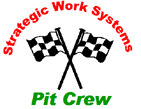A broken clock is right exactly twice each day. But did you ever think about what “right” really means?
An old man walked to work each day checking his watch as he walked through town. On his way, he detoured to the town’s only jewelry store. He would stop there each day and set his watch by the old clock in front of the store. This went on for years. The shopkeeper watched this routine with curiosity and respect for the old man’s consistency as each day passed. Rain or shine, the old man’s daily ritual never changed.
Finally, one day, the jewelry shop owner stepped out of his doorway and asked the old man why he was setting his watch every day. This surprised the old man. He was kind enough to answer what seemed to be an obvious question. He explained, “I stop by here each day on my way to work to set my watch. You see, this old watch may not keep the best time in the world, but it’s the only one I have. And my job is the timekeeper at that old mill up there on the hill. I have to make sure the clocks up there are accurate. Then, every day at four o’clock, I sound the whistle signaling shift change time. So, each day I reset my watch to make sure I sound the whistle at the right time for all of the people who work up there.”
The shopkeeper looked puzzled by this reply. He told the old man, “As you can imagine, this old clock has served us well for many years. And it really doesn’t keep time that well any more. So, each day at four o’clock, I reset it when I hear the mill whistle.” Both men paused, then laughed. Together, they had created their own erroneous time zone in that small mill town for years.
This story should remind us that each day of our lives we do simple things that require thought and care. In many cases, our jobs and our company’s success depend on what we do. What is our standard for doing the right things to take care of our plant and facility equipment? How do we make sure we are doing the right things at the right times, the right way? These questions bring me to a second story, one of personal experience.
One of the machines we were working on recently was an old machine, built in 1939 and refurbished in 1970. It was in remarkably good shape considering its age. It ran as part of a processing line 24 hours a day for 5 to 6 days each week. This machine was picked as a “TPM” target since most of the product quality losses from the processing line could be traced back to it. The data was accurate and reliable. But rarely was this “quality” data used to address maintenance problems the way we did with the pillars of TPM.
Underneath a six-foot-long solid-steel guard were two flat belts. It takes two people to lift the guard off the machine. One of these belts was used to drive the intake drum, the other to drive a takeoff drum. Inspection of these belts revealed that they were worn beyond any usefulness. They showed signs of severe slipping. But according to plant standards, they were not to be replaced unless they were broken: “If they aren’t broke, we don’t replace them.” The preventive maintenance (PM) instructions said, “Check the belts.” So, they checked them.
Upon looking at part of the machine drive system, we noticed a very heavy buildup of fibers. The plant’s PM instructions went on to say “Clean all gears and chains. Oil the chain and sprockets. Grease the gears.” That would seem normal. But that was the opposite of what the equipment manual recommended. On a single page describing lubrication, there was a warning note: “Do not grease or oil the gears and chains. There is extra clearance designed into these components to prevent a buildup of fibers. Grease and oil will attract fibers and cause the parts to bind and jam and the belts to slip.”
So, what about belt slippage? It was the single largest cause of product defects. What is the root cause of belt slippage? Not checking the right source for proper maintenance – the equipment manual; not using the right information to perform the right maintenance at the right time on a critical piece of equipment; assuming that a “common sense approach to basic maintenance” applies across the board. Pick one.
“Right” means doing what the equipment requires. “Right” means consulting accurate and reliable sources to determine the right things to do. “Right” means “right” without a doubt – facts not opinions. Equipment reliability depends on all of us doing the right things the right way.
© 2004
Robert M. Williamson
Strategic Work Systems, Inc.
Columbus, NC 28722
RobertMW2@cs.com
![]() Download a PDF of this article by clicking here Clock Reliability
Download a PDF of this article by clicking here Clock Reliability
